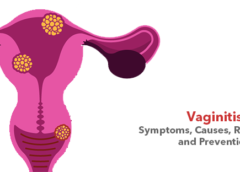Overview
Vaginitis is a vaginal inflammation which can lead to discharge, itching and pain. The cause is typically a change in the vaginal bacteria’s natural balance or an infection. After menopause decreased levels of estrogen and certain skin conditions can also cause vaginitis.
The most common types of vaginitis are:
- Bacterial vaginosis caused by changing the normal bacteria in your vagina to an overgrowth in other organisms
- Yeast infections, usually caused by the naturally occurring Candida albicans fungus
- Trichomoniasis, which is caused by a parasite and usually transmitted through sexual intercourse
Treatment depends on what form of vaginitis you have.
Symptoms of Vaginitis
The most common symptoms of vaginitis include:
- Irritation of the genital area
- Discharge that may be white, grey, watery, or foamy
- Dysuria, which is discomfort or pain while urinating
- Inflammation which results in redness and swelling of the labia majora, labia minora and perineal region, mainly due to excess immune cells
- Painful sexual intercourse, known as dyspareunia
- Foul or fishy vaginal odour
When to call your doctor
You should call your doctor when:
- You feel scratching, pain, swelling or soreness outside or around your vagina
- It burns when you urinate
- Sex is uncomfortable
- Your symptoms are not improving
- You have pelvic pain or a fever
Causes
The cause of this depends on what kind of vaginitis you have:
- Bacterial Vaginosis: This main cause of vaginitis results from a change of the normal bacteria present in your vagina to overgrowth of one of several other organisms. Other bacteria (anaerobes) in your vagina typically outnumber bacteria that are commonly present in the vagina (lactobacilli). When anaerobic bacteria are too numerous, the equilibrium is disrupted, causing bacterial vaginosis.
This kind of vaginitis tends to be associated with sexual intercourse — especially if you have multiple sex partners or a new sex partner — but it also occurs in women who are not sexually active.
- Yeast Infections: These occur when there’s an overgrowth of a fungal organism — usually C. Albicans — in your vagina. C. Albicans also induces infections in other moist areas of your body, such as in your mouth (thrush), skin folds and nail beds. The fungus can also cause diaper rash.
- Trichomoniasis: This widespread sexually transmitted infection is caused by the Trichomonas vaginalis, a microscopic, one-celled parasite. During sexual intercourse, this organism spreads to someone who has the infection.
The organism normally infects the urinary tract in men but sometimes it does not cause any symptoms. Trichomoniasis typically infects the vagina in women and could cause symptoms. It also raises the likelihood that a woman may get other sexually transmitted infections.
- Noninfectious Vaginitis: Vaginal sprays, douches, perfumed soaps, scented detergents, and spermicidal products may cause an allergic reaction or irritate vulvar and vaginal tissue. Foreign items, such as tissue paper or forgotten tampons, may also irritate vaginal tissues in the vagina.
- Menopausal Genitourinary Syndrome (Vaginal Atrophy): Reduced levels of estrogen after menopause or surgical removal of your ovaries may cause thinning of the vaginal lining, often contributing to vaginal pain, burning and dryness.
Risk factors
- Risk factors for vaginitis are determined by the type of vaginitis.
- Multiple sexual partners and unsafe intercourse are risk factors for STDs.
- Some recognized risk factors for bacterial vaginosis include smoking cigarettes, multiple sex partners, douching and the use of contraceptive IUDs
- Risk factors for yeast infection are varied. They may include suppression of the immune system either from cancer or other illnesses or by taking immune suppressant medicines. Use of antibiotic is another known risk factor. Pregnancy, diabetes, oral contraceptives, and douching can all make a woman more likely to develop yeast vaginitis.
Complications
Women with trichomoniasis or bacterial vaginosis are at a higher risk of developing sexually transmitted infections due to the inflammation caused by these conditions. Symptomatic bacterial vaginosis and trichomoniasis in pregnant women have been linked with premature deliveries and babies with low birth weight.
Prevention
The following best practices may help prevent vaginitis:
- Having good overall hygiene
- Using mild soaps without irritants or scents
- Wiping from front to back to prevent bacteria from spreading from the anus to the vagina
- Wearing cotton underwear
- Stop douching and annoying chemicals, like as sprays, soaps and other feminine goods
- Wearing loose-fitting clothing
- Practising sex with a condom
- Using antibiotics only when necessary

Leave a Reply
You must be logged in to post a comment.